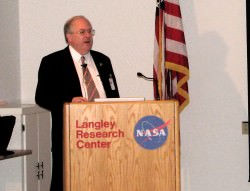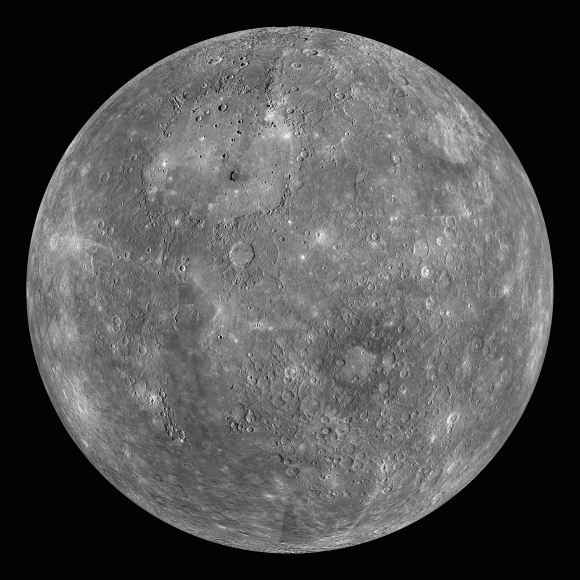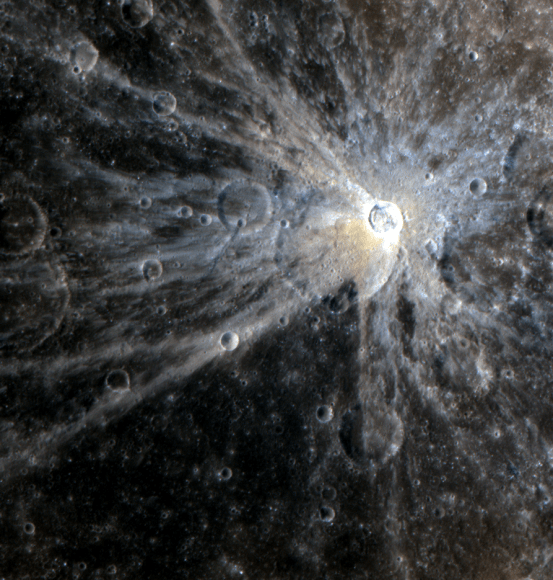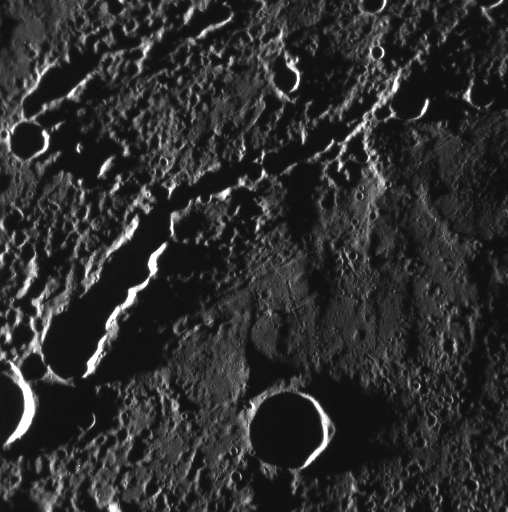[/caption]
Editor’s note: Bruce Dorminey, science journalist and author of “Distant Wanderers: The Search for Planets Beyond the Solar System,” interviews NASA’s MESSENGER mission Project Scientist Ralph McNutt about what we are learning about Mercury.
Thirty-five years after NASA’s Mariner 10 interplanetary probe flew by and imaged less than half of tiny Mercury’s surface, NASA’s MESSENGER spacecraft now orbits our Solar System’s enigmatic and poorly understood innermost planet. After a six-and-a-half-year journey — which included three flybys of Mercury — MESSENGER is now the first spacecraft to take up long-term residence around this hard-to-reach and hellish planet.
Crater-scarred Mercury lies at an average distance of only 58 million kms from the Sun, so searingly close that its angular separation (or elongation) from our own star is never more than 28 degrees. This all makes it extremely difficult to study from Earth.
Thus, planetary scientists are thrilled to finally be analyzing new in situ data from the MESSENGER (MErcury Surface, Space ENvironment, GEochemistry, and Ranging) spacecraft.
To get some perspective on the findings and Mercury itself, we turned to the MESSENGER Project Scientist Ralph McNutt at Johns Hopkins University’s Applied Physics Lab.
Dorminey — Is the MESSENGER data already shaking up Mercury paradigms?
McNutt — Yes – the biggest issue has been the volatile content which is likely going to lead to an interesting, but productive debate, about implications for planetary origins in the inner solar system.
“Volatile” elements are those with relatively low melting and boiling points. “Refractory” elements have relatively high boiling and melting points. If Mercury has a large core due to the surface being “boiled off” by a hot solar wind or hotter Sun in the early days of the solar system, or by a giant impact, then it is more difficult – but perhaps not impossible – for the volatile to refractory ratio, as exemplified by the potassium to thorium ratio (K/Th), to be as high on Mercury as at Earth, Mars, and Venus. And yet that is what the data are saying.
Dorminey — What could explain Mercury’s magnetic field being offset north of the planet’s center by 20 percent of its radius? Was this offset due to a giant impactor?

McNutt — My guess would be that the offset is not due to a giant impactor. But we still do not have a good explanation.
Dorminey — But does the in situ measurement of this magnetic field also confirm that Mercury still has an active magnetic dynamo?
McNutt — There seems to be no way that [Mercury] can escape having a dynamo, so that already makes for implications about Mercury’s cooling history and the chemical mixture [needed] for the dynamo action. There needs to be mostly iron, but something else must be mixed in to help lower the freezing point, otherwise the dynamo should have frozen out some time back.
“Dynamo” in either a planetary or commercial context refers to the generation of electricity by movement of a conductor with respect to a preexisting magnetic filed. Such a movement produces an electrical current, which, in turn, produces a magnetic field.
In a planet, the conductor is a liquid with motion derived from the rotational energy of the planet. But a full theoretical description of how planetary dynamos work is still lacking and is the subject of ongoing research.
Dorminey — A popular formation theory, which would explain its anomalously large iron core, is that early Mercury was stripped of its outer layers following a giant impact. Do you adhere to this idea?
McNutt — Nominally, a high volatile content – expressed via a high potassium to thorium ratio (K/Th), which we have measured with the MESSENGER gamma-ray spectrometer, would rule against such a massive impact. The thinking has been that the volatile content would not re-accrete and so one would be left with a low global average such as is measured for the Moon. We will see – I do not think the verdict is in yet on this one.

Dorminey — What is the significance of and where did it get its surface sulfur and potassium?
McNutt — Sulfur and potassium were both elements in the initial solar nebula. The real question is what led to their placement and relative concentrations on the surface of Mercury.
Dorminey — What’s the significance of the MESSENGER-imaged volcanic vents? Is Mercury still tectonically active?
McNutt — The volcanic vents tells us that volcanism was a significant part of the geologic history of the planet. The planet has cooled a lot since there was a lot of activity and continues to cool. The level of activity is likely low at best – but if we see an active [volcanic] vent, we will definitely let the world know.
Dorminey — We know that Mercury has an exosphere, but could Mercury ever have had anything approaching an Earthlike atmosphere?
McNutt — Any sort of a stable Earth-like atmosphere is not in the cards. Mercury is too small with too small a gravity field to hold on to anything for a long time. If there was sufficiently rapid outgassing , then one could have built up an atmosphere of something that might have Earth-like pressures, but certainly no oxygen, and not for long given the temperature.
Dorminey — What is still the most puzzling to you about Mercury?
McNutt — Right now, the biggest puzzle is how to put together the magnetic field configuration (with the offset), with a dynamo, and the topography and gravity data all in a self-consistent description of the planet. There will be some more papers coming out on these topics in the near future.
Dorminey — If money were no object, what would be the ultimate science exploration strategy for Mercury? Are there any plans in the works for a lander?
McNutt — To really understand the solar system, we need to put together a coherent chronology of formation and early thermal evolution of the planets and other solar system objects. To do that “right” one needs well-characterized samples returned from the surface or drilled from the near-surface, in pristine environments and delivered to labs on Earth. Sample returns are hard – but not as hard as placing such equipment in situ. Following the next level of intense study by BepiColombo (the ESA orbital mission now in development), the next step is a lander. There are no plans for such a mission at present. An interesting question is which is harder: a sample return mission from Mercury or from Venus.
Dorminey — With dayside temperatures of 630 kelvin and nightside temperatures of 95 kelvin, could Mercury have ever been a candidate for liquid water or oceans?
McNutt — No.
Dorminey — Could Mercury have ever had microbial life?
McNutt — Before it was known that Mercury rotated, there was some speculation that there might be a zone of perpetual twilight between the Sun-facing hot side and the Sun-shadowed cold side a “twilight zone” where something [like microbial life] might be possible. In actuality, the region between hot and cold would have been fairly abrupt (depending on the thermal conductivity of the rocks). As Mercury does rotate, no such region exists.

Dorminey — What’s the ultimate significance of planetary science’s study of Mercury? Does it offer a template for what you expect in other solar systems, or does your gut tell you that it’s a total fluke?
McNutt — Knowing more about Mercury, and Venus and Mars tells us about the “terrestrial planets” as a whole and what was common – and special – about ours – and their origins. While the new exoplanet discoveries are extremely interesting, we will not get as close to those planets as we can get to the ones in our own Solar System anytime soon. We have yet to be able to resolve other “Mercurys” in our exoplanet searches, so it is as likely as good a template as any. In learned circles at one time in the not too distant past, the entire solar system was considered to be a total fluke.

